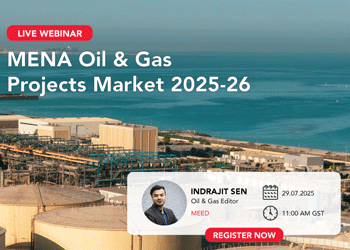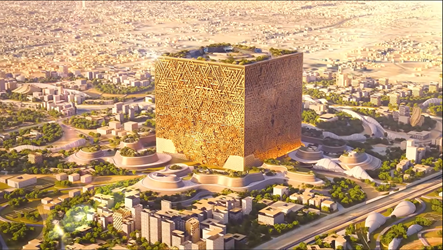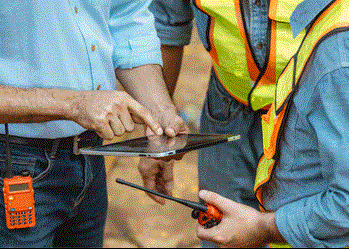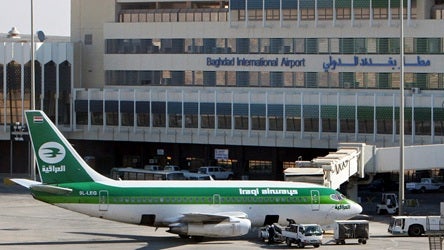Bigger is better for construction
23 December 2024

 Nothing encapsulates a buoyant construction market better than signing a contract to complete the world’s tallest tower. That happened on 2 October 2024, when Saudi Binladin Group (SBG) was awarded a $2bn contract to complete the 1,000-metre-plus Jeddah Tower.
Nothing encapsulates a buoyant construction market better than signing a contract to complete the world’s tallest tower. That happened on 2 October 2024, when Saudi Binladin Group (SBG) was awarded a $2bn contract to complete the 1,000-metre-plus Jeddah Tower.
The award was significant in many ways. It was a revival of the tower project, which has been on hold since 2018, and it was also a comeback for SBG after years of financial stress that had led many in the market to think it would never win another major construction deal.
On a macro level, the construction deal confirmed that the region is home to the world’s most daring and challenging construction projects.
More importantly, these projects are more than just aspirations; they are real projects that are being built.
Biggest contracts
While Jeddah Tower was the most symbolic contract award in 2024, at $2bn, it was not the largest. That accolade went to the Italian contractor WeBuild when it was awarded a $4.7bn contract for the construction of the three dams at the Trojena mountain resort at Neom in January.
Like Jeddah Tower, the project is a challenging one. Time pressure is a key issue. Trojena has been selected to host the 2029 Asian Winter Games, and the reservoir will be used to make the snow for the event. This means the dams must be completed and the reservoir filled well in advance.
The project is also technically complex. The main dam will have a height of 145 metres and will be 475 metres long at its crest. Inside the reservoir there will be a kidney-shaped dam that will house an attraction known as the Enchanted Forest, which will be connected to the rest of the Trojena development by an underwater tunnel.
WeBuild’s involvement also highlighted that international contractors, after sitting on the sidelines for a number of years, are playing an active role in the Saudi construction market.
One market segment that has attracted strong interest is building stadiums, which like Trojena have to be completed for football tournaments with fixed dates: the 2027 Asian Games and the 2034 Fifa World Cup.
In October, Spain’s FCC in joint venture with the local Nesma & Partners secured a $1bn contract to build the Prince Mohammed Bin Salman Stadium at the Qiddiya City development on the outskirts of Riyadh.
Earlier in the year, a joint venture of Belgian contractor Besix and the local Albawani was awarded the contract to build the Aramco football stadium in Al-Khobar, and Beijing-headquartered China Railway Construction Corporation and local contractor Sama Construction for Trading & Contracting won the contract to construct the Jeddah Central stadium project.
Outside of Saudi Arabia, there were only two contract awards valued at over $1bn and both were in the UAE emirate of Abu Dhabi.
In January, a $1.2bn contract to complete phases two and four at the Saadiyat Lagoons project was awarded to a joint venture of two Abu Dhabi-based contractors, Trojan Construction Group and Arabian Construction Company.
The other $1bn-plus deal was a $1.4bn contract to complete dredging and marine works for the Nisi Island development, which was awarded to the local NMDC Group.
These deals were highlights in what was a strong year for the rest of the market. In total, according to regional projects tracker MEED Projects, there were $67.9bn of construction contract awards by the end of October 2024. If the trajectory is maintained until the end of the year, it will result in about $81.4bn of awards, which is lower than the $96.9bn of awards recorded in 2023, but still higher than any of the eight years from 2015 to 2022.
 Market challenges
Market challenges
Replicating the record-breaking performance of 2023 was never going to be easy, especially after Riyadh warned that its spending would be more targeted at the end of 2023. Those comments, made by the finance minister, set the tone for 2024, which proved to be a year with plenty of contract awards, but without the apparent carefree attitude to spending that characterised 2023.
The other challenge with following on from a bumper year is supply chain constraints. With full order books, contractors and suppliers have lost some of the appetite that they had for new work in 2023. The result of this for project clients has been difficulties in attracting enough bidders, and when bids are submitted, the offers are often not competitively priced.
These challenges have been felt most acutely by projects in the remote regions of Saudi Arabia. The issue is so prevalent at Neom that there is now a phenomenon known as ‘Neom inflation’, which implies that the $500bn gigaproject in the remote northwestern corner of the kingdom has its own unique inflation rate.
These regional issues have added to the international supply chain constraints that have been felt since the Covid-19 pandemic and, more recently, during the conflict in Gaza and threats to shipping lanes in the Red Sea.
 Addressing challenges
Addressing challenges
The market has responded to these challenges. In Saudi Arabia, the Public Investment Fund (PIF) invested in four of the kingdom’s largest general contractors in 2023. Then, in February 2024, the sovereign wealth vehicle announced that it had, together with the National Infrastructure Fund, introduced a new contractor financing programme, designed to strengthen the construction sector’s finances.
The programme aims to provide contractors with finance solutions to help improve their cash flows.
Developers have also been improving their contract terms and, crucially, working to ensure payments are processed on time – a move that should also help improve contractor cash flows.
The PIF-backed development companies have also been actively working on attracting new companies to Saudi Arabia. They have been travelling the world on roadshows to attract more contractors and suppliers to projects in the kingdom.
These roadshows have been highlighting the volume and scale of the opportunities in Saudi Arabia, and have shown that the kingdom offers long-term opportunities for companies that come and invest in the market.
In the UAE, Abu Dhabi has invested heavily in its construction supply chain. With its government-controlled investment vehicles and a series of interconnected mergers and acquisitions, Abu Dhabi and its ruling family now own the emirate’s key contracting companies and the suppliers of vital raw materials such as cement and steel.
These national champions shield Abu Dhabi from many, but not all, supply chain challenges that have impacted projects in other markets.
Meanwhile, in Dubai, where the real estate market is driving construction, private sector developers are courting contractors to work on their projects.
As private entities, they are not bound by the procurement regulations that government or government-controlled developers have, so they have been offering directly negotiated deals to help guarantee that their projects are delivered on time.

2025 outlook
Unless the market dynamics shift dramatically, the market will likely face many of the same challenges in 2025.
One of the overriding fears is a sharp slowdown in project spending in Saudi Arabia. This has happened before and is a valid concern, and the market has already shown signs of plateauing in some areas.
This is most noticeable when contract awards for the five official gigaprojects – Diriyah, Neom, Qiddiya, Red Sea Global and Roshn – are examined. After a sharp ramp-up in awards from 2020 to 2023, the pace of contract awards levelled off in 2024, which reflects budgetary concerns within the development companies and the PIF, and the market’s ability to take on such large volumes of new work.
With budgets under pressure, developers in Saudi Arabia are increasingly looking for investment to help fund their projects. The success of these efforts will determine how buoyant the market in the kingdom remains over the long term.
Even if investment comes in, it will take time, which means there will likely be a degree of conservatism from development companies in 2025. This was signalled in mid-November, when Neom, while announcing the exit of CEO Nadhmi Al-Nasr and the appointment of Aiman Al-Mudaifer as acting CEO, said: “As Neom enters a new phase of delivery, this new leadership will ensure operational continuity, agility and efficiency to match the overall vision and objectives of the project.”
While there may be a pause in spending on some of the Saudi gigaprojects, other schemes continue to underpin the performance of the construction market.
Oil prices remain supportive of government spending on projects across the Gulf, and for the private sector, in markets such as the UAE, real estate projects continue to move into construction as developers rush to deliver units to investors and capitalise on the ongoing strength of the property market.
Exclusive from Meed
-
 WEBINAR: Mena Oil & Gas Projects Market 2025-26
WEBINAR: Mena Oil & Gas Projects Market 2025-2610 July 2025
-

-
 Chinese firm wins Mid Island Parkway tunnelling deal
Chinese firm wins Mid Island Parkway tunnelling deal10 July 2025
-
 Iraq tenders Baghdad airport PPP project
Iraq tenders Baghdad airport PPP project9 July 2025
-

All of this is only 1% of what MEED.com has to offer
Subscribe now and unlock all the 153,671 articles on MEED.com
- All the latest news, data, and market intelligence across MENA at your fingerprints
- First-hand updates and inside information on projects, clients and competitors that matter to you
- 20 years' archive of information, data, and news for you to access at your convenience
- Strategize to succeed and minimise risks with timely analysis of current and future market trends

Related Articles
-
 WEBINAR: Mena Oil & Gas Projects Market 2025-26
WEBINAR: Mena Oil & Gas Projects Market 2025-2610 July 2025
Date & Time: Tuesday 29 July 2025 | 11:00 AM GST
Agenda:
1. Summary of the Mena oil, gas and petrochemicals projects market
2. Summary description of the main megaprojects, including project programmes
3. Analysis of active contracts and spending to date
4. Analysis of top contracts by work already awarded
5. Long-term capital expenditure outlays and forecasts
6. Highlights of key contracts to be tendered and awarded over the next 18 months
7. Top contractors and clients
8. Breakdown of spending by segment, ie, oil, gas, petrochemicals – upstream, downstream, onshore and offshore
9. Q&A session
https://image.digitalinsightresearch.in/uploads/NewsArticle/14241705/main.gif -
 New Murabba signs up South Korean firm for design works
New Murabba signs up South Korean firm for design works10 July 2025
Register for MEED’s 14-day trial access
Saudi Arabia’s New Murabba Development Company (NMDC) has signed a memorandum of understanding (MoU) with South Korea’s Heerim Architects & Planners to explore further design works on assets at the 14 square-kilometre New Murabba downtown project.
According to an official statement: “Heerim Architects & Planners will explore distinctive architectural plans that complement the development’s masterplan, with special focus on anchor assets, linear parks and smart city features.”
New Murabba CEO Michael Dyke signed the agreement last week during the company’s Investment and Partnership Forum in Seoul.
At the event, NMDC also signed an MoU with South Korea’s Naver Cloud Corporation to explore technological solutions for delivering the New Murabba downtown project.
According to an official statement: “The three-year agreement covers exploring innovative technology and automation to support the delivery of New Murabba, including robotics, autonomous vehicles, a smart city platform and digital solutions for monitoring construction progress.”
NMDC is in Seoul to examine technological offerings, assess financing options and showcase the investment opportunities available for the New Murabba downtown development.
The statement added that the excavation works for The Mukaab, the centrepiece of the overall development, have now been completed.
The Mukaab is a Najdi-inspired landmark that will be one of the largest buildings in the world. It will be 400 metres high, 400 metres wide and 400 metres long. Internally, it will have a tower on top of a spiral base and a structure featuring 2 million square metres (sq m) of floor space designated for hospitality. It will feature commercial spaces, cultural and tourist attractions, residential and hotel units, and recreational facilities.
Downtown destination
The New Murabba destination will have a total floor area of more than 25 million sq m and feature more than 104,000 residential units, 9,000 hotel rooms and over 980,000 sq m of retail space.
The scheme will include 1.4 million sq m of office space, 620,000 sq m of leisure facilities and 1.8 million sq m of space dedicated to community facilities.
The project will be developed around the concept of sustainability and will include green spaces and walking and cycling paths to promote active lifestyles and community activities.
The living, working and entertainment facilities will be developed within a 15-minute walking radius. The area will use an internal transport system and will be about a 20-minute drive from the airport.
The downtown area will feature a museum, a technology and design university, an immersive, multipurpose theatre, and more than 80 entertainment and cultural venues.
 READ THE JULY 2025 MEED BUSINESS REVIEW – click here to view PDF
READ THE JULY 2025 MEED BUSINESS REVIEW – click here to view PDFUAE and Turkiye expand business links; Renewed hope lies on the horizon for trouble-beset Levant region; Gulf real estate momentum continues even as concerns emerge
Distributed to senior decision-makers in the region and around the world, the July 2025 edition of MEED Business Review includes:
> AGENDA: UAE-Turkiye trade gains momentum> INTERVIEW 1: Building on UAE-Turkiye trade> INTERVIEW 2: Turkiye's Kalyon goes global> INTERVIEW 3: Strengthening UAE-Turkiye financial links> INTERVIEW 4: Turkish Airlines plans further growth> CURRENT AFFAIRS: Middle East tensions could reduce gas investments> GCC REAL ESTATE: Gulf real estate faces a more nuanced reality> PROJECTS MARKET: GCC projects market collapses> INTERVIEW 5: Hassan Allam eyes role in Saudi Arabia’s transformation> INTERVIEW 6: Aseer region seeks new investments for Saudi Arabia> LEADERSHIP: Nuclear power makes a global comeback> LEVANT MARKET FOCUS: Levant states wrestle regional pressures> GULF PROJECTS INDEX: Gulf projects index continues climb> CONTRACT AWARDS: Mena contract award activity remains subdued> ECONOMIC DATA: Data drives regional projects> OPINION: A farcical tragedy that no one can endTo see previous issues of MEED Business Review, please click herehttps://image.digitalinsightresearch.in/uploads/NewsArticle/14239016/main.jpg -
 Chinese firm wins Mid Island Parkway tunnelling deal
Chinese firm wins Mid Island Parkway tunnelling deal10 July 2025

Register for MEED’s 14-day trial access
Beijing-headquartered China Railway Tunnel Engineering Group has won a $60m subcontract for the tunnelling works on package 1B of the Mid Island Parkway project in Abu Dhabi.
Package 1B entails the construction of a cut-and-cover tunnel to cross the Khor Laffan Channel, which is the area between the Saadiyat and Um-Yifeenah islands.
The tunnel, which will be between 900 metres and 1 kilometre (km) long, is being constructed on a design-and-build basis and will tie in to packages 1A and 1C.
The project is being jointly constructed by a joint venture of local firm Yas Projects (Alpha Dhabi Holding) and Beijing-based China Railway International Group.
In June last year, MEED exclusively reported that Abu Dhabi's Department of Municipality & Transport had awarded contracts for three packages for phase one of the Mid Island Parkway Project (MIPP), as part of the Plan Capital urban evolution programme.
Phase one will start at the existing Saadiyat Interchange, which will connect the E12 road to the MIPP, and will end with the recently constructed Um-Yifeenah Highway.
It comprises a dual main road with a total length of 8km, including four traffic lanes in each direction, two interchanges, a tunnel and associated infrastructure works.
MIPP phase one is further divided into packages 1A, 1B and 1C, which were awarded separately.
The project ownership has been transferred from Aldar Properties to Abu Dhaibi's Department of Municipalities & Transport.
Previously, it was transferred from Abu Dhabi General Services Company (Musanada) to Aldar Properties, and the project was included in the Abu Dhabi Investment Office's public-private partnership project pipeline.
 READ THE JULY 2025 MEED BUSINESS REVIEW – click here to view PDF
READ THE JULY 2025 MEED BUSINESS REVIEW – click here to view PDFUAE and Turkiye expand business links; Renewed hope lies on the horizon for trouble-beset Levant region; Gulf real estate momentum continues even as concerns emerge
Distributed to senior decision-makers in the region and around the world, the July 2025 edition of MEED Business Review includes:
> AGENDA: UAE-Turkiye trade gains momentum> INTERVIEW 1: Building on UAE-Turkiye trade> INTERVIEW 2: Turkiye's Kalyon goes global> INTERVIEW 3: Strengthening UAE-Turkiye financial links> INTERVIEW 4: Turkish Airlines plans further growth> CURRENT AFFAIRS: Middle East tensions could reduce gas investments> GCC REAL ESTATE: Gulf real estate faces a more nuanced reality> PROJECTS MARKET: GCC projects market collapses> INTERVIEW 5: Hassan Allam eyes role in Saudi Arabia’s transformation> INTERVIEW 6: Aseer region seeks new investments for Saudi Arabia> LEADERSHIP: Nuclear power makes a global comeback> LEVANT MARKET FOCUS: Levant states wrestle regional pressures> GULF PROJECTS INDEX: Gulf projects index continues climb> CONTRACT AWARDS: Mena contract award activity remains subdued> ECONOMIC DATA: Data drives regional projects> OPINION: A farcical tragedy that no one can endTo see previous issues of MEED Business Review, please click herehttps://image.digitalinsightresearch.in/uploads/NewsArticle/14238039/main3047.gif -
 Iraq tenders Baghdad airport PPP project
Iraq tenders Baghdad airport PPP project9 July 2025
Register for MEED’s 14-day trial access
Iraq’s Ministry of Transport and the General Company for Airport & Air Navigation Services have released a tender inviting firms to bid for a contract to develop Baghdad International airport on a public-private partnership (PPP) basis.
The notice was issued in July, and the submission deadline is in September.
According to an official statement posted on its website, Iraq’s Ministry of Transport said that 10 out of 14 international consortiums that expressed interest in the project earlier this year have been prequalified to compete for the tender.
The scope of the estimated $400m-$600m project involves rehabilitating, expanding, financing, operating and maintaining the airport. It is the first airport PPP project to be launched in Iraq.
The initial capacity of the airport is expected to be around 9 million passengers, which will be gradually increased to 15 million passengers.
The International Finance Corporation (IFC), a member of the World Bank Group, is the project’s lead transaction adviser.
Iraq is already developing the Baghdad and Najaf-Karbala metro projects using a similar PPP model.
Earlier this month, MEED reported that Iraq intends to retender the contract to develop and operate the Baghdad Metro project, following the award of the estimated $2.5bn contract last year.
According to local media reports, Nasser Al-Assadi, adviser to Prime Minister Mohammed Sudani, stated that the previous developers had overestimated the project budget; therefore, the government will relaunch the entire process to implement the project.
https://image.digitalinsightresearch.in/uploads/NewsArticle/14229008/main.jpg -
 Contractors prepare revised bids for Roshn stadium
Contractors prepare revised bids for Roshn stadium9 July 2025

Register for MEED’s 14-day trial access
Saudi gigaproject developer Roshn has invited firms to submit revised commercial proposals by 24 July for a contract to build a new stadium adjacent to the National Guard facilities to the southwest of Riyadh.
Known as the National Guard Stadium, it will be delivered on an early contractor involvement (ECI) basis. It will cover an area of over 450,000 square metres and be able to accommodate 46,000 spectators.
The scope of work also covers the construction of auxiliary facilities, including training academy offices and two hotels, as well as retail and food and beverage outlets.
The firms had initially submitted bids on 8 April for the contract.
The stadium is scheduled to host 32 Fifa World Cup tournament games in 2034.
In August last year, MEED reported that Saudi Arabia plans to build 11 new stadiums as part of its bid to host the 2034 Fifa World Cup.
Eight stadiums will be located in Riyadh, four in Jeddah and one each in Al-Khobar, Abha and Neom.
The proposal outlines an additional 10 cities that will host training bases. These are Al-Baha, Jazan, Taif, Medina, Al-Ula, Umluj, Tabuk, Hail, Al-Ahsa and Buraidah.
The bid proposes 134 training sites across the kingdom, including 61 existing facilities and 73 new training venues.
The kingdom was officially selected to host the 2034 Fifa World Cup through an online convention of Fifa member associations at the Fifa congress on 11 December 2024.
 https://image.digitalinsightresearch.in/uploads/NewsArticle/14228507/main.jpg
https://image.digitalinsightresearch.in/uploads/NewsArticle/14228507/main.jpg

